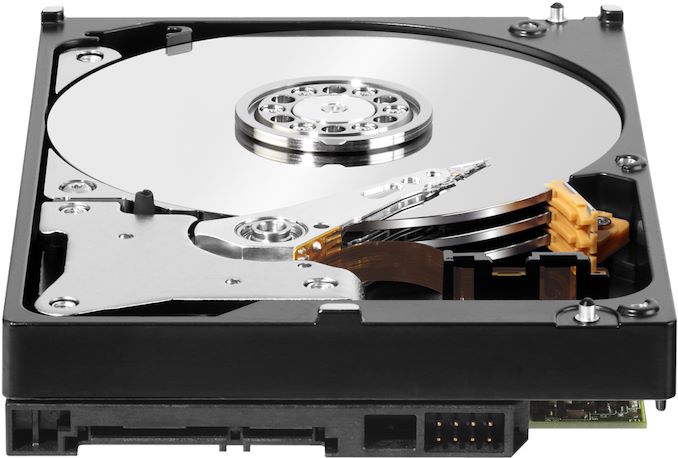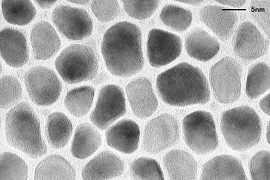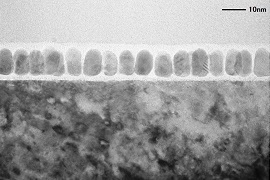The Road to 80 TB HDDs: Showa Denko Develops HAMR Platters for Hard Drives
by Anton Shilov on February 6, 2020 2:30 PM EST- Posted in
- Storage
- Seagate
- Toshiba
- Western Digital
- HAMR
- Showa Denko
- SDK
- HDD

Showa Denko K.K. (SDK) has unveiled the the company has finished the development of its next-generation heat assisted magnetic recording (HAMR) media for hard drives. The platters use all-new magnetic thin films with a very small crystal grain size in order to maximize their areal density, with the goal of eventually enabling 3.5-inch HDDs to be built with capacities of 70 TB to 80 TB.
SDK’s platters for HAMR HDDs use glass substrate and feature thin film magnetic layer made of an Fe-Pt alloy. To improve the magnetic coercivity of the media by several times over existing platters, Showa Denko used a new structure of magnetic layers and implemented new ways of controlling the temperature of the media during production.
UPDATE 2/21: As it turns out, Showa Denko will use glass substrates for platters designed for HAMD hard drives because of their superior heat resistance.
Driving these developments, it's critical to maximize the magnetic coercivity of next generation HDD platters because the crystal grains used to record data are getting extremely small. This has made them very easy to magnetize, but it has also reduced the strength of the individual magnetic signatures, which creates an unwanted magnetic inter-track interference (ITI) effect that makes it harder for HDD heads to read the data. Platters with high magnetic coercivity require energy assistance during writing and this is what energy assisted magnetic recording technologies (HAMR, MAMR, ePMR, etc.) are all about. Meanwhile, the platters must survive extreme temperatures they are subjected to during heat-assisted recording. According to Showa Denko, its new HAMR platters offer the industry’s highest read-write characteristics and durability.
Transmission Electron Microscopy Images of HAMR Media
Plain View Cross Section
SDK is not disclosing the recording density of its new platters nor are they making specific promises about when it intends to start mass production of next-generation disks. Meanwhile, the company notes that today’s leading-edge conventional magnetic recording (CMR) platters feature recording density of about 1.14 Tb/in2 and it is widely believed that this is not going to grow significantly without using energy assisted recording methods. By contrast, Showa Denko believes, HAMR-based media will achieve areal density of 5-6 Tb/in2 in the future, which will increase capacity of hard drives by several times, all the way to 70 TB – 80 TB per 3.5-inch drive without increasing the number of platters. For comparison's sake, today’s 16 TB CMR (PMR+TDMR) HDDs use nine disks, so increasing their density by ~5.2X would enable drives featuring capacities higher than 80 TB.
Showa Denko is the world’s largest independent maker of platters for hard drives, selling media to all of the HDD producers. That said, the large manufacturers — Seagate and Western Digital — also produce media themselves and tend to use their own leading-edge platters to cut costs and maximize product margins. So it will be interesting to see which of three remaining hard drive makers will be the first to use HAMR platters from Showa Denko.
Seagate will be the first company to adopt HAMR for commercial 20 TB drives in late 2020, but since Showa Denko now only plans to ‘make preparations for full-scale supply of the new HD media’, it is likely that the first HAMR drives will use Seagate’s own platters. Toshiba is expected to use Showa Denko’s 2 TB MAMR platters for its 18 TB HDDs that are projected to arrive later this year, but in the longer terms it will switch to HAMR (we have no idea when). By contrast, Western Digital uses its so-called energy-assisted PMR (ePMR) technology for its 18 TB and 20 TB HDDs due this year and will gradually move to MAMR and HAMR in the years to come.
Related Reading:
- Toshiba's HDD Tech Roadmap: A Mix of SMR, MAMR, TDMR, and HAMR
- 18 TB HDDs: Toshiba Collaborates with Showa Denko for MAMR HDDs
- HOYA Starts to Build Next-Gen HDD Glass Substrate Production Facility
- Seagate: 18 TB HDD Due in First Half 2020, 20 TB Drive to Ship in Late 2020
- Western Digital Roadmap Updates: Energy Assisted Recording, Multi-Stage Actuators, Zoned Storage
Source: Showa Denko












75 Comments
View All Comments
Cellar Door - Thursday, February 6, 2020 - link
Imagine doing a RAID rebuild on a 80TB array..quorm - Thursday, February 6, 2020 - link
Drives so big they're impractical for anything except cloud.prisonerX - Thursday, February 6, 2020 - link
"640K ought to be enough for anyone..."rocky12345 - Thursday, February 6, 2020 - link
Yep Mr Bill Gates thought so way back in the 1980's when he said 640K was more than enough for any modern computer to have installed.Cullinaire - Thursday, February 6, 2020 - link
Maybe it would have been, but for certain applications that demanded a ridiculous % free of the 640k life could get difficult if you were dependent on a lot of TSRs...Samus - Friday, February 7, 2020 - link
Considering 500GB HDD's and now SSD's have been the mainstream capacity for the VAST majority of PC's for over a DECADE, using Bill Gates analogy is an apples to oranges comparison.Storage needs have grown incredibly slowly and in many markets have reversed, because of cloud computing making Quorm's statement that much more correct. Very few people have large hard disks in their homes, and even fewer people have disk arrays. The majority of computer users, from home to small business, have cloud based file storage and cloud based backups. Medium business and enterprise all have cloud backups and on-site backups for servers, but these aren't the people being targeted with these massive-capacity drives...most of those servers take near-line SAS drives, often 2.5", anyway.
deil - Friday, February 7, 2020 - link
That's because time/price ratio of doing this yourself vs buying same service from blackblaze for example is so skewed into cloud that its almost no point of homemade stuff.Unless you do illegal stuff that is OR have privacy issues.
with 1GB/50MB down/up link, its even faster to backup on BB than locally.
Golgatha777 - Friday, February 7, 2020 - link
Well, my cable modem with its 1GbE only has a 35 Mb/sec uplink. Not to mention a 1TB data cap. Unless you're fortunate enough to have AT&T or Google Fiber, local backups are still the only way to backup TBs of data reliably and in a timely fashion.azazel1024 - Friday, February 7, 2020 - link
Huh? What do you think you'd be backing up to locally? I have 2x1GbE between my desktop and server. My internet is 200/200Mbps, which actually seems to hit about 250/230Mbps. Pretty thankful I have that, but my local backups are 10x faster than anything over the internet possibly could be. And for cost, I'd need a >1TB plan. Ignore my movie folder (which are almost all BR rips of movies I own, a few are still DVDs), I still have >1TB of data between home movies of my kids, photos, music, exe/zip of games (GOG, rips from old DVD game disks, etc).I see that plenty, like Dropbox, now are up to 2TB for $9.99 a month. But if I did want to backup my movie library (which I've spent a couple of hundred hours, plus many hundreds of hours of compute time/electricity on ripping my BRs for my personal use. So I could do it again, but that is a HUGE investment of my time I'd like to protect), 2TB wouldn't cut it (I am up over 3.5TB total data). Just using Dropbox's options, they max at 3TB.
So not even an option for me. But if I could trim the fat and get it under 3TB, I'd be looking at $16.58 a month. Round it to $200 a year. Total investment in my server has been around $500 for all hardware, drives, etc. That was...I dunno, 4 or 5 years ago? Something like that. I pay around $15 a year in electrical costs to run the server.
And I can't stream to my apple TV from dropbox...
Sure I know my setup is a lot more unique than probably 97% of home users. But you can't even say that on skewed into the cloud as no point.
A friggen USB3 2TB pocket hard drive is like $100 and way faster than 99.999% of residential internet connections available in the US (maybe slower than the .001% who have a 2Gbps internet connection).
I also wouldn't call it privacy issues. Maybe privacy CONCERNS would be more appropriate.
I have friends who don't have anything like a media library from piracy. Hell I helped a neighbor setup a backup routine to a 2TB USB drive they bought a couple of years ago and hadn't gotten around to doing anything with. She had about 600GB of videos and photos of her kids from her husbands camera and their phones to backup. Along with a few GB of work related files from her SE job. That can sure fit in most cloud accounts, but that external USB drive is also...again less than $100. And DB would be more than that in a year. Let alone over years.
I use cloud storage for some of my most important files where I want FOUR copies of it, one offsite. But it isn't remotely a replacement for "homemade stuff", unless you just want easy. It isn't faster. It isn't cheaper.
evernessince - Friday, February 7, 2020 - link
Mainstream Capacity for HDDs is 2TB. 500GB drives haven't been mainstream since Windows 7 first launched.For some people a 500GB SSD might be enough, assuming you do not play too many games or have too many apps. It will certainly fill up quickly installing modern AAA titles at 120GB each though.
FYI, moving the storage need from a local machine to the cloud doesn't make that quote any more correct. People still need that storage, whether it comes from the cloud or not irregardless. One way or another, you are still paying for that drive space, whether it's through selling your information or through a subscription.